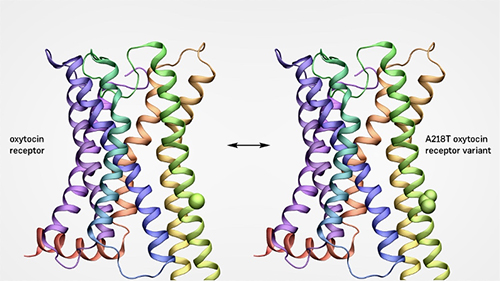Oxytocin and Autism: HBP Researchers Provide New Insights into the Cellular Origin of the Disorder
18 February 2022
Scientists around HBP researcher Paolo Carloni from HBP partner Forschungszentrum Jülich show how genetic variation in the oxytocin receptor changes its structure and function. Their findings have implications for the treatment of autism spectrum disorder. They were recently published in the renowned journal Molecular Psychiatry.

Structure of the oxytocin receptor (left) and the mutant receptor variant A218T (right)
Copyright: Forschungszentrum Jülich/Mercedes Alfonso-Prieto
Much of the brain’s function in health and disease is highly influenced by signalling molecules that unfold their different effects by binding to specific receptors on the outside of the neuronal cell. One of them is oxytocin, which has been found to strengthen social bonding and promote trust and empathy. These behavioural traits are caused by binding of the hormone to the oxytocin receptor in the brain.
Changes in the finely tuned mechanism of oxytocin interacting with its receptor have long been suspected to play a role in psychosocial disorders. A specific variant of the oxytocin receptor was previously linked to autism spectrum disorder. However, the causal mechanisms are still unknown, and first therapy attempts administering oxytocin via a nasal spray had shown to help only some individuals but not others.
Researchers at the University of Regensburg together with a team around HBP researcher Paolo Carloni at Forschungszentrum Jülich have now elucidated how a genetic variation that is associated with autism spectrum disorder affects signalling pathways inside cells.
The new findings describe in detail how the mutation in the DNA sequence affects the activity of the receptor. Contrary to what might intuitively be expected, the mutation increases the stability of the oxytocin receptor in human cell lines. Using computer modelling, the researchers discovered that the receptor variant is more active than the wild type, which is also likely to have a dysregulating effect on its response to oxytocin.
The findings provide a better understanding of why nasal sprays with oxytocin may not always be helpful to treat autistic people and point to alternative strategies that could lead in the long term to new therapies aimed at restoring the normal response levels of the receptor.
Original publication: Magdalena Meyer, Benjamin Jurek, Mercedes Alfonso-Prieto, Rui Ribeiro, Vladimir M. Milenkovic, Julia Winter, Petra Hoffmann, Christian H. Wetzel, Alejandro Giorgetti, Paolo Carloni & Inga D. Neumann. Structure-function relationships of the disease-linked. Molecular Psychiatry (2022), DOI: 10.1038/s41380-021-01241-8.



